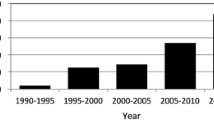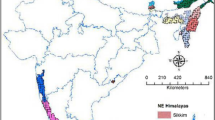Abstract
Garhwal Himalayas are seismically very active and simultaneously suffering from landslide hazards. Landslides are one of the most frequent natural hazards in Himalayas causing damages worth more than one billion US$ and around 200 deaths every year. Thus, it is of paramount importance to identify the landslide causative factors to study them carefully and rank them as per their influence on the occurrence of landslides. The difference image of GIS-derived landslide susceptibility zonation maps prepared for pre- and post-Chamoli earthquake shows the effect of seismic shaking on the occurrence of landslides in the Garhwal Himalaya. An attempt has been made to incorporate seismic shaking parameters in terms of peak ground acceleration with other static landslide causative factors to produce landslide susceptibility zonation map in geographic information system environment. In this paper, probabilistic seismic hazard analysis has been carried out to calculate peak ground acceleration values at different time periods for estimating seismic shaking conditions in the study area. Further, these values are used as one of the causative factors of landslides in the study area and it is observed that it refines the preparation of landslide susceptibility zonation map in seismically active areas like Garhwal Himalayas.














Similar content being viewed by others
Abbreviations
- DEM:
-
Digital elevation model
- GIS:
-
Geographic information system
- GPS:
-
Global positioning system
- G–R Relationship:
-
Gutenberg–Richter relationship
- GSI:
-
Geological survey of India
- HS:
-
High susceptibility
- IRS:
-
Indian remote sensing
- LISS:
-
Linear imaging self-scanning
- LS:
-
Low susceptibility
- LSI:
-
Landslide susceptibile index
- LSZ:
-
Landslide susceptibility zonation
- Mb :
-
Short period teleseismic P-wave magnitude from vertical component record
- Ml :
-
Local magnitude from horizontal and/or vertical component derived from original or simulated Wood-Anderson seismograph records
- MMI:
-
Modified Mercalli intensity scale
- MS:
-
Moderate susceptibility
- Ms :
-
Surface-wave magnitude from vertical and/or horizontal component records
- M w :
-
Moment magnitude
- NDVI:
-
Normalized difference vegetation index
- NIR:
-
Near-infrared
- PAN:
-
Panchromatic
- PGA:
-
Peak ground acceleration
- PGD:
-
Peak ground displacement
- PGV:
-
Peak ground velocity
- PSHA:
-
Propbabilistic seismic hazard analysis
- SOI:
-
Survey of India
- SWIR:
-
Short wave infrared
- VHS:
-
Very high susceptibility
- VLS:
-
Very low susceptibility
References
Abrahamson NA, Young RR (1992) A stable algorithm for regression analysis using the random effects model. Bull Seismol Soc Am 82(1):505–510
Ahemed A, Sharma ML, Sharma A (2006) Wavelet based automatic phase picking algorithm for 3-component broadband seismological data, workshop on Himalayan earthquake : a fresh appraisal, HIMEQ-2006, October 7–8, 2006. Dehradun, India
Anbalagan R (1992) Landslide hazard evaluation and zonation mapping in mountainous terrain. Eng Geol 32:269–277
Arora MK, Das Gupta AS, Gupta RP (2004) An artificial neutral network for landslide hazard zonation in the Bhagirathi (Ganga) Valley, Himalayas. Int J Remote Sens 25(3):559–572
Atkinson GM, Boore DM (1995) Ground motion relations for eastern North America. Bull Seismol Soc Am 85:17–30
Champati Ray PK, Dimri S, Lakhera RC, Sati S (2007) Fuzzy-based method for landslide hazard assessment in active seismic zone of Himalaya. Landslides 4(2):101–111
GSI (2001) Bulletin Series—B No. 53 Chamoli earthquake of 29 March, 1999, Published by GSI, p 163
Gupta RP (2003) Remote sensing geology, 2nd edn. Springer, Berlin, p 655
IS 1893 (Part 1) 2002 Criteria for earthquake resistance design of structure, general provisions and buildings, Bureau of Indian Standards, p 36
Johnston AC (1996) Seismic moment assessment of earthquakes in stable continental regions, Part-II: instrumental seismicity. Geophys J Int 124:381–414
Joyner WB, Boore DM (1993) Methods for regression analysis of strong motion data. Bull Seismol Soc Am 83:469–487
Lindholm C (2001) Seismotectonics and earthquake hazard. A disseration for the degree of Doctor Philosphiae. ISBN 82-92220-04-6
Lindholm C, Bungum H (2000) Probabilistic seismic hazard. A review of the seismological frame of reference with examples from Norway. Soil Dyn Earthq Eng 20:27–38
Mahajan AK, Pandey HC (2002) Macroseismic observation of Chamoli earthquake of 29th March 1999 and its engineering aspects. J Himal Geol 23(1&2):1–6
Mathew J, Buechel S, Sponheuer W (2007) Weights of evidence modeling for landslide hazard zonation mapping in part of Bhagirathi valley. Uttarakhand Curr Sci 92(5):628–638
Ordaz M, Aguilar A, Arboleda J (2003) Crisis 2007. Instituto de Ingenieria, UNAM, Mexico
Owen LA, Kamp U, Khattak GA, Harp EL, Keefer DK, Bauer MA (2008) Landslides triggered by the 8 October 2005 Kashmir earthquake. Geomorphology 94(1–2):1–9
Pachauri AK, Pant M (1992) Landslide hazard mapping based on geological attributes. Eng Geol 32(1–2):81–100
Pachauri AK, Gupta PV, Chander R (1998) Landslide zoning in a part of the Garhwal Himalayas. Environ Geol 36(3–4):325–334
Pareek N, Sharma ML, Arora MK (2009) Impact of seismic factors on landslide susceptibility zonation: a case study in part of Indian Himalayas. Landslides 7(2):191–201
Prakash A, Fielding EJ, Gens R, Genderen JL, Evans DL (2001) Data fusion for investigating land subsidence and coalfire hazards in a coal mining area. Int J Remote Sens 22(6):921–932
Ravindran KV, Philip G (2002) Mapping of 29th March 1999 Chamoli earthquake induced landslides using IRS-IC-ID data. J Himal Geol 23(1–2):69–76
Reid HF (1911) The elastic rebound theory of earthquakes. Bull Dept Geol Univ Berkeley 6:413–444
Sabins FF (1996) Remote sensing principles and interpretations, 494. W. H. Freeman & Co., New York
Saha AK, Gupta RP, Arora MK (2002) GIS-based landslide hazard zonation in a part of the Himalayas. Int J Remote Sens 23(2):357–369
Saha AK, Arora MK, Csaplovics E, Gupta RP (2004) Land cover classification using IRS LISS III imagery and DEM in a rugged terrain: a case study in Himalaya. Geo-Carto-Int 20(2):33–40
Saha AK, Gupta RP, Sarkar I, Arora MK, Csaplovics E (2005) An approach for GIS-based statistical landslide susceptibility zonation: with a case study in the Himalayas. Landslides 2(1):61–69
Sanjeevi S, Vani K, Lakshmi K (2001) Comparison of conventional and wavelet transform techniques for fusion of IRC-1c LISS-III and PAN images. In: Proceedings of Asian conference on remote sensing, Singapore 5–9 November 2001, pp 140–145
Saraf AK (2000) IRS-1C-PAN depicts Chamoli earthquake induced landslides in Garhwal Himalayas, India. Int J Remote Sens 21(12):2345–2352
Sarkar S, Kanungo DP, Mehrotra GS (1995) Landslide hazard zonation: a case study in Garhwal Himalaya, India. Mount Res Deve 15(4):301–309
Sato HP, Hasegawa H, Fujiwara S, Tobita M, Koarai M, Une H, Iwahashi J (2007) Interpretation of landslide distribution triggered by the 2005 Northern Pakistan earthquake using SPOT 5 imagery. Landslides 4(2):113–122
Schell AB, Eriksson LG, Murphy BE, Boylan D, Kiling M, Gregory JL (1985) Application of seismotectonic zoning to regional site screening, characterization and selection, Association of engineering geologists abstracts and Program 74 (October, 1985)
Shanmugam P, Sanjeevi S (2001) Analysis and evaluation of fusion techniques using IRS-1C LISS-3 and pan data for monitoring coastal wetlands of Vedaranniyam, Tamil Nadu. In: Proceedings of the national symposium on advances in remote sensing technology with special emphasis on high resolution imagery & annual convention of Indian Society of remote sensing (ISRS), Ahmedabad, India, 11–13 December, 2001, pp 60–65
Sharma ML (2003) Seismic hazard in Northern India region. Seismol Res Lett 74(2):140–146
Sharma ML, Dubey RN (2000) Seismological aspects, In Report: Chamoli earthquake of March 29, 1999, Department of Earthquake Engineering, IIT Roorkee, Roorkee, India, p 89
Sharma PK, Chopra R, Verma VK, Thomas A (1996) Flood management using remote sensing technology: the Punjab (India) experience. Int J Remote Sens 17(17):3511–3521
Sinha BN, Varma RS, Paul DK (1975) Landslides in Darjeeling district and adjacent areas. Bull Geol Surv India 36(B):1–10
Solonenko VP (1977) Landslides and collapses in seismic zones and their prediction. Bull Int As Eng Geol 15:4–8
Suckale J, Grunthal G, Regnier MC (2005) Probabilistic seismic hazard assessment for Vanuatu, Scientific Technical Report STR 05/16 Geo Forschungs Zentrum, Potsdam
Süzen ML, Doyuran V (2004) Data driven bivariate landslide susceptibility assessment using geographical information systems: method and application to Asarsuyu catchment, Turkey. Eng Geol 71:303–321
Utsu T (2002) Statiscal features of seismicity. Int Handb Earthq Eng Eng Seismol 81A:719–732
Valdiya KS (1980) Geology of Kumaun Lesser Himalaya. Wadia Institute of Himalayan Geology, Dehradun, p 291
van Westen CJ (1997) Statistical landslide hazard analysis. In: Application Guide, ILWIS 2.1 for Windows, ITC, Enschede, The Netherlands, pp 73–84
Welch R, Ehlers M (1987) Merging multiresolution SPOT HRV and landsat TM data. Photogramm Eng Remote Sens 53(3):301–303
Yalchin A (2008) GIS-based landslide susceptibility mapping using analytical hierarchy process and bivariate statistics in Ardesen (Turkey): comparisons of results and confirmations. Catena 72(1):1–12
Yoseph B, Ramana GV (2008) Probabilistic seismic hazard analysis at selected sites in Addis Adaba, Ethopia. Int J Geotech Eng 3(1):202–205
Youngs RR, Chiou SJ, Silva WL, Humphrey JR (1997) Strong ground motion attenuation relationships for subduction zone earthquakes based on empirical data and numerical modelling (abs.). Seismol Res Lett 64:1818–1830
Acknowledgments
Naveen Pareek is thankful to the Ministry of Human Resource Development, Govt of India for providing financial support during his PhD work and data procurement used in this work. The paper has benefited by valuable comments by an anonymous reviewers on the earlier version of the manuscript. We are also grateful to the editor for suggestions to improve the paper.
Author information
Authors and Affiliations
Corresponding author
Rights and permissions
About this article
Cite this article
Pareek, N., Sharma, M.L., Arora, M.K. et al. Inclusion of earthquake strong ground motion in a geographic information system-based landslide susceptibility zonation in Garhwal Himalayas. Nat Hazards 65, 739–765 (2013). https://doi.org/10.1007/s11069-012-0390-3
Received:
Accepted:
Published:
Issue Date:
DOI: https://doi.org/10.1007/s11069-012-0390-3




